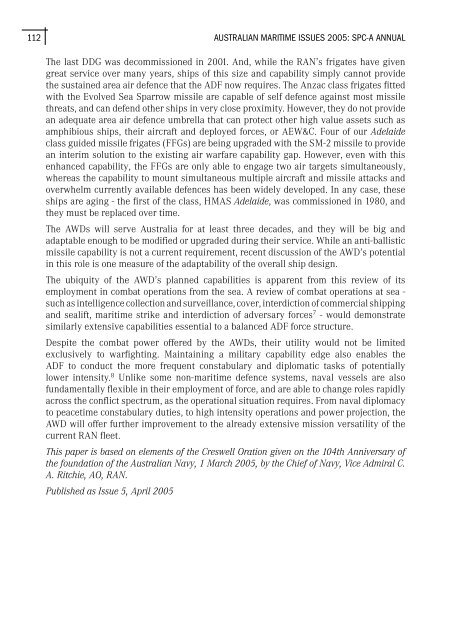Australian Maritime Issues 2005 - Royal Australian Navy
Australian Maritime Issues 2005 - Royal Australian Navy
Australian Maritime Issues 2005 - Royal Australian Navy
Create successful ePaper yourself
Turn your PDF publications into a flip-book with our unique Google optimized e-Paper software.
112<br />
AUSTRALIAN MARITIME ISSUES <strong>2005</strong>: SPC-A ANNUAL<br />
The last DDG was decommissioned in 2001. And, while the RAN’s frigates have given<br />
great service over many years, ships of this size and capability simply cannot provide<br />
the sustained area air defence that the ADF now requires. The Anzac class frigates fitted<br />
with the Evolved Sea Sparrow missile are capable of self defence against most missile<br />
threats, and can defend other ships in very close proximity. However, they do not provide<br />
an adequate area air defence umbrella that can protect other high value assets such as<br />
amphibious ships, their aircraft and deployed forces, or AEW&C. Four of our Adelaide<br />
class guided missile frigates (FFGs) are being upgraded with the SM-2 missile to provide<br />
an interim solution to the existing air warfare capability gap. However, even with this<br />
enhanced capability, the FFGs are only able to engage two air targets simultaneously,<br />
whereas the capability to mount simultaneous multiple aircraft and missile attacks and<br />
overwhelm currently available defences has been widely developed. In any case, these<br />
ships are aging - the first of the class, HMAS Adelaide, was commissioned in 1980, and<br />
they must be replaced over time.<br />
The AWDs will serve Australia for at least three decades, and they will be big and<br />
adaptable enough to be modified or upgraded during their service. While an anti-ballistic<br />
missile capability is not a current requirement, recent discussion of the AWD’s potential<br />
in this role is one measure of the adaptability of the overall ship design.<br />
The ubiquity of the AWD’s planned capabilities is apparent from this review of its<br />
employment in combat operations from the sea. A review of combat operations at sea -<br />
such as intelligence collection and surveillance, cover, interdiction of commercial shipping<br />
and sealift, maritime strike and interdiction of adversary forces 7 - would demonstrate<br />
similarly extensive capabilities essential to a balanced ADF force structure.<br />
Despite the combat power offered by the AWDs, their utility would not be limited<br />
exclusively to warfighting. Maintaining a military capability edge also enables the<br />
ADF to conduct the more frequent constabulary and diplomatic tasks of potentially<br />
lower intensity. 8 Unlike some non-maritime defence systems, naval vessels are also<br />
fundamentally flexible in their employment of force, and are able to change roles rapidly<br />
across the conflict spectrum, as the operational situation requires. From naval diplomacy<br />
to peacetime constabulary duties, to high intensity operations and power projection, the<br />
AWD will offer further improvement to the already extensive mission versatility of the<br />
current RAN fleet.<br />
This paper is based on elements of the Creswell Oration given on the 104th Anniversary of<br />
the foundation of the <strong>Australian</strong> <strong>Navy</strong>, 1 March <strong>2005</strong>, by the Chief of <strong>Navy</strong>, Vice Admiral C.<br />
A. Ritchie, AO, RAN.<br />
Published as Issue 5, April <strong>2005</strong>

















